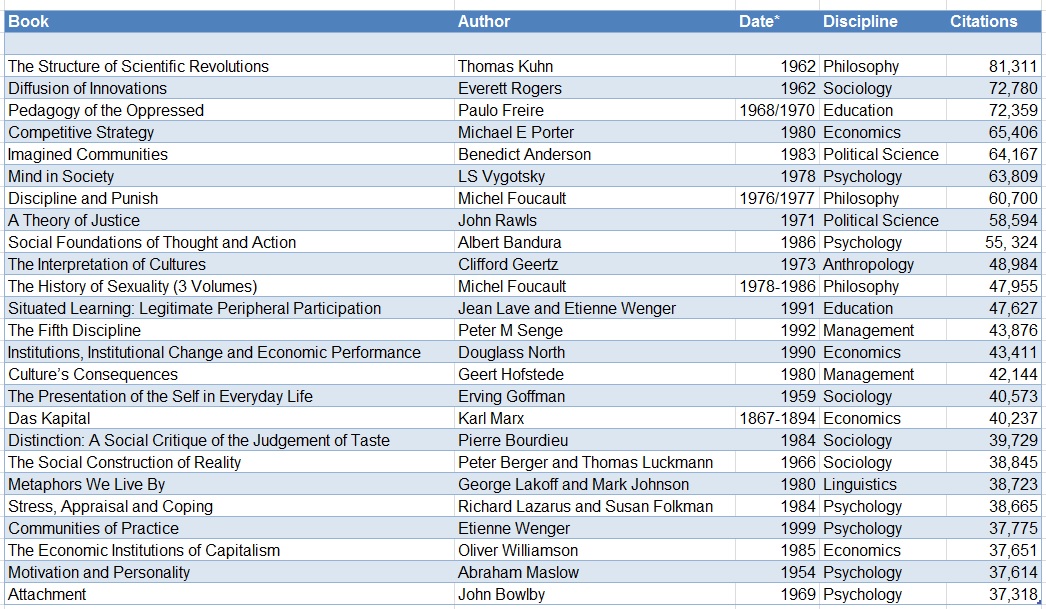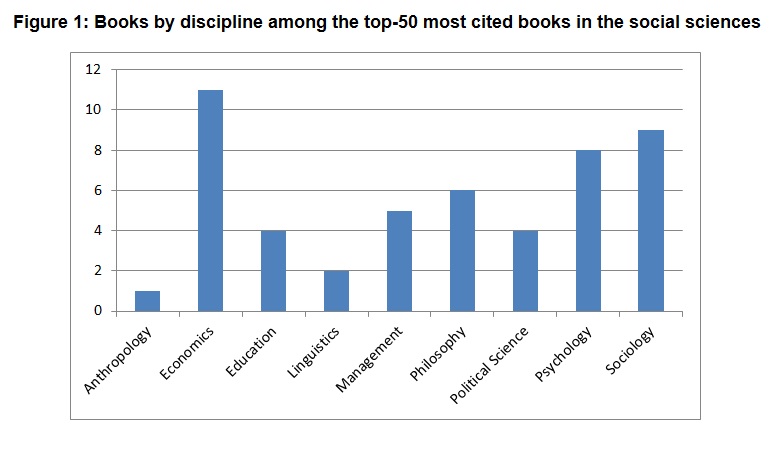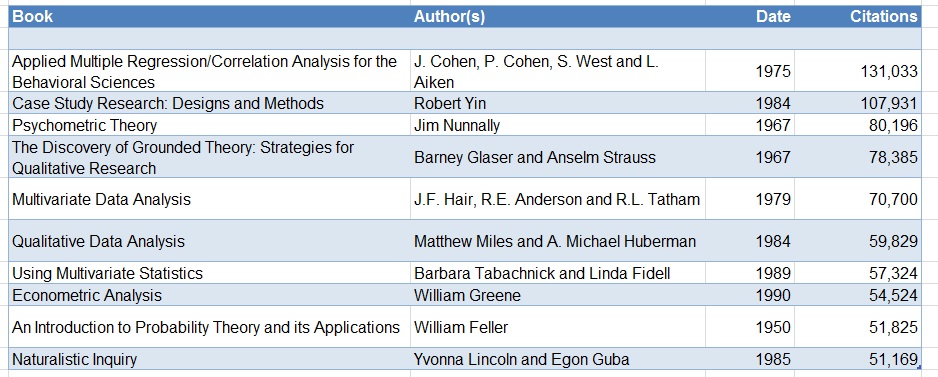What are the most-cited publications in the social sciences (according to Google Scholar)?
 Drawing on citation data that spans disciplines and time periods, Elliott Green
Drawing on citation data that spans disciplines and time periods, Elliott Greenhas identified the most cited publications in the social sciences. Here
he shares his findings on the 25 most cited books as well as the top
ten journal articles. The sheer number of citations for these top cited
publications is worth noting as is the fact that no one discipline
dominates over the others in the top 20, with the top six books all from
different disciplines.
There has been an increasing focus
on citations as a measure of academic productivity in recent years, in
part due to the increased ease of access to data from Google Scholar
since it was launched in 2004. While there has thus been a large amount
of interest in how scholars can obtain higher numbers of citations,
there has been comparatively little attention to examining what
publications actually obtain huge citation counts. There has been one study from Nature in
2014 of the top 100 most cited publications using data from Google
Scholar, which included papers across all academic disciplines. Due to
higher citation counts in the natural sciences, the list thus included
very few publications from the social sciences (with only one spot in
the top ten), of which a large number were actually methodology
textbooks.
As such it is worth constructing a similar list, but just for the
social sciences. I used Google Scholar to create a list of all
publications which drew more than 20,000 citations, which I sub-divided
into books and journal articles due to the fact that some disciplines
tend to publish more in one format than the other, as well as
methodology publications (including econometrics and statistics as well
as qualitative methodology) due to the fact that methodology
publications tend to be cited as if they were textbooks and can thus
attract much higher citation counts than other publications.
 Image credit: Archives New Zealand (CC BY-SA)
Image credit: Archives New Zealand (CC BY-SA)
I included the following disciplines in my list: Anthropology, Economics, Education, Geography, Linguistics, Management, Philosophy,
Political Science and Psychology. I thus excluded publications from both
the humanities and the natural sciences, which in some borderline cases
meant that I had to decide whether a publication belonged in the list
due to its subject matter. In such cases I tended to decide based on the
author’s degrees and/or professional title in order to maintain some
degree of objectivity: thus I included Judith Butler’s Gender Trouble (1990)
as she has a PhD in philosophy despite holding a professorship in a
Literature department, but I did not include Homi Bhabha’s The Location of Culture (1994)
as his PhD is in English literature. On the natural sciences side I
similarly chose to exclude Lofti Zadeh’s 1965 article “Fuzzy Sets”
despite its use in the social sciences as Zadeh holds a PhD in
Engineering. In cases of books with multiple volumes such as Karl Marx’s
Kapital I combined the citations for all volumes, and I
confronted the problem of works published in multiple languages by only
including citations of English-language editions for publications
initially published in English, and citations of both the original
language and English-language editions for works published initially in
other languages. (In all but one cases this algorithm captured the two
highest amounts of citations for foreign language publications. The one
exception was Paulo Freire’s Pedagogy of the Oppressed (1968), whose Spanish-language edition has more citations than its original Portuguese-language edition.)
I begin with the list of the top 25 most published books in Table 1.
Several things are immediately apparent. First is the sheer number of
citations for the most-cited books: the most cited book, Thomas Kuhn’s
book The Structure of Scientific Revolutions, has more
citations that the entire body of work of such noted social scientists
as John Stuart Mill (74,807 citations), Daniel Dennett (67,625), Avinash
Dixit (61,112) or Steven Pinker (58,574). Secondly, no one discipline
dominates over the others in the top 20, with the top six books all from
different disciplines. However, if we expand our analysis to the top 50
books, as seen in Figure 1, economics dominates over other disciplines,
followed by sociology and psychology. In contrast geography is totally
absent from the list, with its highest-cited book, David Harvey’s The Condition of Postmodernity (1989), coming in at 65th on the list, and no other book in anthropology has more than 20,000 citations other than Clifford Geertz’s The Interpretation of Cultures (1973).
Table 1: The 25 most cited books in the social sciences
 * Single-volume
* Single-volume
books originally published in a foreign language are listed twice, with
the English-language edition listed second.

Third, there is a distinct inverted-U shape curve to the date of
publication, with books published between 1960 and the early 1990s
dominating over both older and newer books. In Figure 2 I plot the
distribution of date of publication by decade for books in the top 50,
which shows that the 1980s and 1990s dominate over other decades. The
only books in the top 50 published within the last 20 years are Robert
Putnam’s Bowling Alone (2001), Amartya Sen’s Development as Freedom (1999) and Etienne Wenger’s Communities of Practice (1999); on the other end the only two books published more than a century ago are Adam Smith’s The Wealth of Nations (1776) and Karl Marx’s Das Kapital (published initially in German between 1867 and 1894).

Indeed, given the strong trend towards recent publications it is
useful just to examine the top ten most cited books published before
1950, which I list in Table 2. As in the top 50 economics dominates over
other disciplines, with six of the top seven spots; in contrast there
are no books published in anthropology, geography, linguistics,
management, or political science before 1950 with more than 20,000
citations.
Table 2: The 10 most cited books in the social sciences published before 1950
 * Books originally published in a foreign language are listed twice, with the English-language edition listed second.
* Books originally published in a foreign language are listed twice, with the English-language edition listed second.
It is useful to compare the list in Table 1 to a list of the top 10 most cited methodology books, which can be found in Table 3. As
expected, the numbers of citations are incredibly high, such that
merging Tables 1 and 3 would result in methodology books taking up half
of the top 10. Another point to note here is the much better
representation of female authors in Table 3, where three books have at
least one female co-author and one, Using Multivariate Analysis (1989), is authored by two women. In contrast the highest non-methodology ranked book authored or co-authored by a woman is Stress, Appraisal and Coping (1989) by Richard Lazarus and Susan Folkman at #19, followed by Judith Butler’s Gender Trouble at #27.
Table 3: The 10 most cited methodology books in the social sciences

Another useful exercise is to compare the top ten books in Table 1 to
the second-most cited books by the same authors as a measure of
consistency. One would expect the ratio to start relatively high and
then decline if the gap in citations between the second-most cited books
was smaller than for the most-cited books, and indeed as expected the
first three authors in based on the raking in Table 1, Thomas Kuhn,
Everett Rogers and Paulo Freire, all have higher ratios than the last
four on the list. However, the clear outlier here is Benedict Anderson,
whose second-most cited publication, his 1998 book The Spectre of Comparisons, has only 979 citations, for a ratio of 68.6 to 1. One point to observe about Anderson’s Imagined Communities is
that, like some other books on the list, many if not most of its
citations tend to be references to its title (i.e., that nations are
“imagined communities”) rather than anything actually inside the book,
leading one author to write about Imagined Communities that “rarely has a critical best-seller been so popular and so ignored at the same time.”
Figure 3: Ratio of most-cited publication to
second-most-cited publication for authors among the top-10 most cited
books in the social sciences

Table 4: The 10 most cited journal articles in the social sciences (excluding methodology articles)

Finally, I examine in Table 4 the top 10 most cited journal articles,
excluding methodological articles. (If such articles were included they
would occupy three of the top six spots, starting with E. Kaplan and P.
Meier’s 1958 article “Nonparametric Estimation from Incomplete
Observations” from the Journal of the American Statistical Association.)
Here the list is dominated by economics and psychology, with four
publications each; in contrast the top ranked article in political
science is R. Axelrod and WD Hamilton’s 1981 article “The Evolution of
Cooperation” in Science at #22, with no articles from
anthropology, education, geography or linguistics with more than 20,000
citations. Another thing to note is the relatively low numbers compared
to Table 1, where there are seventeen publications with more than 40,000
citations compared to only four journal articles.
Note: This article gives the views of the author, and not the
position of the LSE Impact blog, nor of the London School of Economics.
Please review our Comments Policy if you have any concerns on posting a comment below.
About the Author
Elliott Green is Associate Professor of Development
Studies in the Department of International Development at the LSE. His
research on ethnic politics, decentralization and development in
Sub-Saharan Africa has been published recently in such journals as Comparative Politics, Economic Development and Cultural Change and International Studies Quarterly, among others.
Impact of Social Sciences – What are the most-cited publications in the social sciences (according to Google Scholar)?
No comments:
Post a Comment